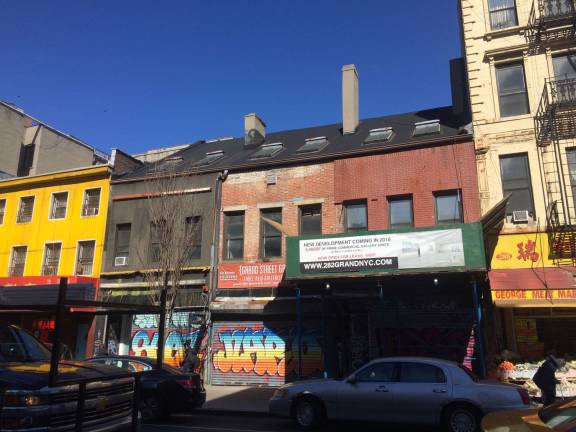Is chinatown the city's new arts district?

Chelsea's gallery district has reigned as the heart of the city's contemporary art movement since the late 1990s.
But could skyrocketing rents, coupled to the availability of cheaper options in other parts of the city, mean the district is losing some of its cachet with gallerists?
An August 2016 report by StreetEasy found that real estate prices near the High Line had increased by nearly 50 percent since the park's opening in 2011.
Longtime Chelsea gallerists have recently made the move to the Lower East Side (Danziger Gallery and CRG), and new galleries are skipping over Chelsea altogether and setting up shop downtown (Magenta Plains, for example, which opened on Allen Street, just north of Broome Street, last year).
Gallerists have also set their sights on Chinatown. Marc Straus, who has been collecting art since he was in college, opened his gallery at 299 Grand St., near Allen, in 2011.
Straus is now planning on tearing down three nearly 200-year-old buildings at 282-286 Grand St. that he also owns and developing an 8-story luxury condominium building with an attached 6,000 square feet of gallery space on their footprint.
Open air markets there closed about two years ago.
“It's going to be modern,” said Ken Tan, art director and partner at Marc Straus Gallery. “But still [will] respect and acknowledge the Lower East Side.”
According to Tan, Grand Street is fast becoming the epicenter for arts on the Lower East Side. The condo and gallery space development, he suggested, could attract artists who can't afford rents in areas like Chelsea or Midtown.
“More avant-garde or fresh ideas can happen, a little bit because the local community of that area is a part of things like that, but also because of practical factors like the rent is cheap versus something in Midtown where it's too expensive to experiment,” said Tan.
Earl Bateman, a real estate broker who represents galleries, including on Grand Street, agreed that Chinatown's lower rents make the district ripe as an incubator creative district.
“It's a business but it's more than a business,” he said of opening a gallery. “It's an opportunity to show new art, new creativity and make a living at the same time.”
Bateman, though, said the market for gallery openings in the Lower East Side/Chinatown neighborhoods “is growing ever so slowly.”
Although there are about 200 galleries in the area, growth is “negligible,” despite the lower rents. “There's more churn there now. I don't know that it's a stable gallery district,” he said. “It's good for a gallery that's undercapitalized.”
Straus, though, is not a new arrival to the Lower East Side. His father, a Polish immigrant, first opened a textile goods store called Roman Cotton Goods at 299 Grand St. in 1943. Straus' father later bought 282-286 Grand St. and expanded his business in what was the original Garment District.
Today, the area bustles with Chinese businesses. Marc Straus had been renting his Grand Street buildings to local business owners, but after noticing an emerging arts scene, he opened his Grand Street gallery in 2011.
“Having a gallery ourselves on Grand Street, we of course are inclined towards having another gallery on Grand Street that's for someone else,” Tan said.
Despite that, Tan doesn't actually see the condos housing artists in the future. Instead, he said, they will most likely appeal to working adults who want to live in the Lower East Side.
“I understand that there's a certain market rate that's going here,” he said. “I'm not sure if it's for everybody.”
And that's a concern, particularly for longtime residents of Chinatown.
The Chinatown Art Brigade, an artists' collective that organizes around tenants' rights and other social justice issues, counted at least 100 new galleries that opened up in the Lower East Side in 2016. According to the Chinatown Art Brigade's ManSee Kong, residents of Chinatown and the Lower East Side are concerned that the influx of galleries will gentrify the neighborhood and raise residential rents.
Kong said about 250 people showed up to an October meeting and “expressed how they were feeling stressed ... as they saw all these galleries appear and replace all these small businesses.”
The addition of luxury condos to the neighborhood will most likely raise additional concerns. The sleek developments will stand out in comparison to neighboring buildings. On one side of the soon to be demolished buildings is a Chinese food market. On the other side, a Chinese bakery. Across the street is a row of Chinese businesses: a flower shop, restaurant and several clothing shops.
“Chinatown is a working-class, ethnic immigrant community. Folks depend on these kinds of immigrant enclaves as a social network of cultural and ethnic resources,” said Melanie Wang, who works as an organizer with the Chinatown Tenants Union. “When galleries come in and are displacing businesses that provide those services and those employment opportunities, it represents a significant threat to the fabric of Chinatown's social community.”
An artist herself, Kong said that it's important for artists themselves to be involved in the community and to listen to the voices of current tenants “to be aware of the space that they're taking up and their privileges.”